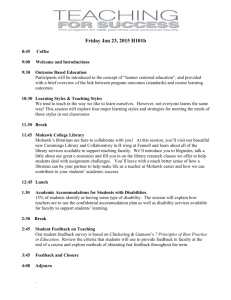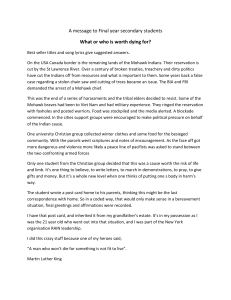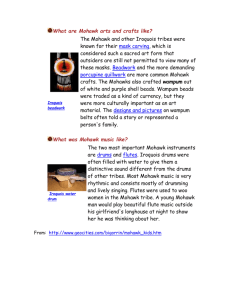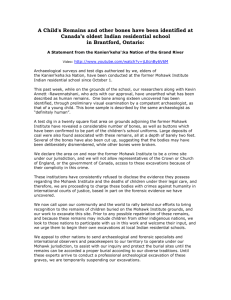air EMP 2012-2013 ANNUAL
advertisement
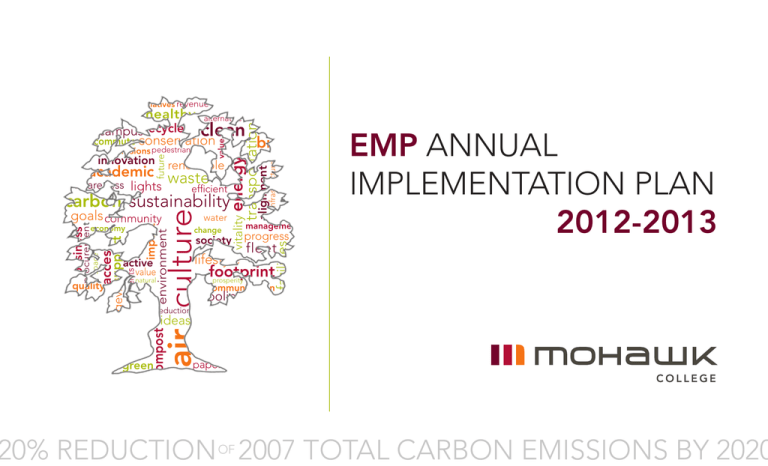
initiatives revenue efficient goals community water air culture value students natural change society lifestyle management progress fleet footprint prosperity communication policy reduction ideas compost quality active environment impact access longevitysupport economy space business procurement carbon sustainability infrastructure awareness lights EMP ANNUAL IMPLEMENTATION PLAN 2012-2013 facilities academic renewable waste bicycl alignment innovation future emissions pedestrian transportation clean commute conservation vitality energy campus recycle alternative value healthy green paper 20% REDUCTION OF 2007 TOTAL CARBON EMISSIONS BY 2020 EMP IMPLEMENTATION PLAN 2012-2013 Backgroundpage 1 Breakdownpage 2 Metrics & Evaluationpage 3 1.0 Waste Management & Paper Consumption 1.2 Energy Waste Reduction Strategy 1.4 Recycling, Compost & Solid Waste Strategy page 4 3.0 Procurementpage 6 3.1 Sustainable Procurement Policies 4.0 Local Food and Health & Wellness 4.1 Local, Healthier Food Options 5.0 Transportation & Vehicle Emissions 5.2 page 8 Active & Alternative Transportation 6.0 Alternative Energy page 7 page 9 6.1 Renewable Energy Production 8.0 Change Management page 10 8.1 Stakeholder Engagement 8.2 Public Awareness 8.4 Environmental Stewardship & Academic Credit 2012 - 2013 Contents Actions at a Glance • Energy Conservation Strategy • Waste Management Strategy • Plastics Ban • Water Conservation • Procurement Workshop • Procurement Policy Development • Campus Food Stand • Food Services Contract • Plate Transparency Campaign • Staff HSR Pass • Ridership & Parking Study • Carpooling • Smart Commute Program • Restricted-Access Bike Parking Facility • MSA Bike Loan Program • Corporate Car Share & Low Carbon Fleet • District Energy Plan • Clean Energy Plan • Investment Fund/Ancillary Fee • Volunteer Opportunities • CSEP Position • Community Involvement • Co-Op Student • Capstone Projects EMP IMPLEMENTATION PLAN 2012-2013 Background: Environmental Management Plan Mohawk College is committed to conducting business in ways which positively impact people the environment and the economy. Developed in 2011, the Environmental Management Plan (EMP) is the leading policy document and blueprint that will shape the College’s transformation towards a greener, prosperous future as an environmentally, socially and financially conscious institution. The EMP will play a vital role in Mohawk’s future success, as the global sustainability movement progresses from a grassroots movement to a global reality. Mohawk has adopted a multi-faceted definition of sustainability which recognizes the interconnection between economy, society and the environment in creating a high quality of life for students, staff and the community at large. This plan was developed based on the understanding that achieving sustainability requires participation from all levels of the College structure as well as students and other community members. In collaboration with Zerofootprint, Mohawk completed a baseline Greenhouse Gas Inventory for 2007 carbon emissions and followed the study with a series of Carbon Roundtables in which over 170 students, staff and faculty provided their input. The EMP was developed based on the results of the GHG inventory and feedback collected from the Roundtable sessions. The completion of a GHG inventory identifies the activities and operations contributing to Mohawk’s carbon footprint while enabling the development of meaningful and appropriate emission reduction strategies, and creating benchmarks for future assessment. The EMP sets a reduction target which calls for a 20% reduction of 2007 baseline carbon emissions by 2020. Nurturing a sustainable culture at Mohawk will contribute to the College’s ability to continually recruit and retain students, provide positive working and learning environments, and to remain competitive with other post-secondary institutions while building on Mohawk’s reputation within the community and beyond. Achieving the long-term emissions reduction target will minimize the College’s impact on the environment by reducing the carbon footprint, will lower operational costs and will increase financial stability and long-term vitality of the College. This plan calls upon all staff and students to contribute to developing the sustainable culture at Mohawk College and will require the creation of new programs, policy development and changes to decision-making across a broad range of issues. Conducting business to positively impact people, the environment and the economy page 1 EMP IMPLEMENTATION PLAN 2012-2013 Breakdown: Annual Implementation Plan The EMP provides direction and sets priorities by proposing a set of Pillars which represent key areas of focus, encompassing the many practices that contribute to Mohawk’s carbon footprint. This includes campus buildings, College fleet, paper use, student and staff commuting, waste produced on campus, and procurement, as well as awareness and engagement. WORK PLAN: GOAL These Pillars are associated with a set of Strategies aimed at reducing carbon emissions in these key areas. The Strategies will be carried out through a set of Actions which identify operational and activity changes which will also improve social and economic environments for stakeholders. A long-term Work Plan outlining these Actions was developed concurrently with the EMP. These Actions represent operational and activity changes, and must be carried out to support the Strategies which will help Mohawk College achieve the ultimate goal of a 20% reduction of total 2007 carbon emissions by 2020. The long-term Work Plan distinguishes some of these changes as Priority Actions, which are to be addressed on a short-term basis. This document, the Annual Implementation Plan, is comprised of the Priority Actions identified in the Work Plan and will guide actions and sustainable initiatives through the year. This plan identifies desired outcomes for each task, as well as timelines for completion. PILLAR STRATEGY ACTIONS The Implementation Plan will be reviewed and updated annually by the Sustainability Steering Committee, and will be presented to the Mohawk Executive Group. An annual environmental scorecard will be presented to the Mohawk College Board of Governors. PRIORITY ACTIONS ANNUAL PLAN Conducting business to positively impact people, the environment and the economy page 2 EMP IMPLEMENTATION PLAN 2012-2013 Metrics & Evaluation To ensure the success of the EMP, Mohawk must continually measure, monitor and communicate the progress of each Pillar, Strategy and Action. On-going evaluation will allow the College to identify areas of strength and weakness, and to respond accordingly in the interest of achieving the long-term reduction target and, ultimately, sustainability as an institution. In keeping with the three-pillared approach to sustainability, actions and their outcomes will be analysed for environmental, financial and social impact. By establishing a set of metrics, Mohawk is ensuring that all actions are in alignment with the Pillars of Sustainability and that tangible, positive outcomes will be produced. Metrics will also play a key role in securing internal or external funding, and in justifying continued support for sustainable initiatives from all levels of the College. In the Annual Implementation Plan, the breakdown of each Pillar is followed by a summary chart which also includes a column indicating which set of metrics will be used for evaluation: S Social F Financial E Environmental Conducting business to positively impact people, the environment and the economy SOCIAL: Social return on investment will allow monitoring of the level of stakeholder and community engagement, and will track improvements to quality of life. Where tangible or quantifiable values are unattainable, qualitative data such as surveys and stakeholder feedback will be applied FINANCIAL: Financial metrics will help to incorporate Return on Investment into large, high initial cost strategies and actions, with proof of benefits to the college’s long-term bottom line. This metric will be applied to Actions aimed at reducing annual operating costs. ENVIRONMENTAL: Environmental metrics will allow tracking and reporting (locally, and with government agencies, etc.) to Mohawk’s stakeholders. Environmental metrics will be focused on Greenhouse Gas emissions where appropriate. In other cases, the industry standard will be used. page 3 EMP IMPLEMENTATION PLAN 2012-2013 1.0 Waste Management & Paper Consumption This pillar examines waste management in a number of contexts including solid waste (garbage, recycling, compost), energy, water, and paper usage. The proposed strategies address all waste that results directly from campus operations and stakeholder activity. They call for intensive research, policy development, infrastructure upgrades, and an emphasis on the development of a sustainable culture for Mohawk College. This will be achieved through stakeholder engagement, on-campus initiatives and living lab experiences tied to academic programming. Successful implementation of these strategies will result in lower operational costs, a reduced carbon footprint and will better prepare the College for longevity as an environmentally-conscious institution. Strategy #1.2 Conservation/Energy Waste Strategy Identifying energy wasting and unnecessary energy consumption while maximizing the energy that is used will help the College reduce it’s carbon footprint and lower annual operational costs at all campuses. Actions: • Energy Conservation Strategy ACTION Energy Conservation Strategy IMPLEMENTATION TIMELINE RESULT Working with Facility Services, identify strategies, programs and initiatives that support energy conservation on campus. *Image used under Creative Commons from ManoharD Conducting business to positively impact people, the environment and the economy March 2013 *Image used under Creative Commons from Advanced Telemetry METRICS S F E *Image used under Creative Commons from Orange Steeler page 4 EMP IMPLEMENTATION PLAN 2012-2013 Strategy #1.4 Recycling, Composting & Solid Waste Strategy: Reducing the total amount of waste generated by Mohawk business outlets, offices, classrooms, food outlets, events and the waste brought to campus by students and staff. This can be achieved through the introduction of waste reduction and diversion strategies that are part of a college-wide waste management strategy. Actions: • Recycle, Compost & Solid Waste Management Strategy • Campus Ban of Single-Use Plastic Bottles & Bags • Water Conservation ACTION IMPLEMENTATION TIMELINE RESULT Waste Management Strategy Working with Facility Services, identify strategies for longterm waste reduction and diversion targets for all campus waste March 2013 Single-Use Plastics Ban Working with Facility Services, identify strategies for a ban on sale and distribution of single-use water bottles and plastic bags July 2012 Water Conservation Work with Facility Services to identify water conservation strategies and expand water refill stations March 2013 *Image used under Creative Commons from The Local People Photo Archive Conducting business to positively impact people, the environment and the economy METRICS S F E F E F E *Image used under Creative Commons from stevendepolo page 5 EMP IMPLEMENTATION PLAN 2012-2013 3.0 Procurement This pillar considers campus locations, existing buildings, outdoor and natural space, future development, and integration with the broader community. The proposed strategies will ensure a future ready campus that will best serve current and future students, and help make Mohawk an employer of choice. Drawing on the skills of our students and staff to help create a College that reflects our values and identity, Mohawk must take a proactive approach to all current and future facilities to support sustainability and a positive experience for staff and students. Strategy #3.1 Sustainable Procurement Policies In this context, value for money includes the consideration of many factors such as cost, performance, availability, quality and environmental performance. Green procurement also requires an understanding of the environmental aspects and potential impacts and costs, associated with the life cycle assessment of goods and services being acquired. The supporting administrative processes and procurement methods outlined by a Procurement Policy can also offer opportunities to reduce the environmental impact of Mohawk’s operations. Actions: • Procurement Workshop • Develop new procurement guidelines ACTION RESULT IMPLEMENTATION TIMELINE Procurement Workshop Half-day workshop including current suppliers, external experts, internal staff, and students to help shape new policies November 2012 Guideline Development Mohawk’s own set of industry leading procurement standards February 2013 Conducting business to positively impact people, the environment and the economy METRICS S F E page 6 EMP IMPLEMENTATION PLAN 2012-2013 4.0 Local Food and Health & Wellness This pillar focuses on the overall health and wellbeing of Mohawk students, staff and faculty. As the global movement centered on healthier, localized food alternatives continues to grow, Mohawk must commit to an increase in the total percentage of local, healthier food options offered on campus. In addition to food, Mohawk must continue to offer services that support healthy ways of living through activities, academic and recreational programming on campus, and through campus wellness facilities. Healthy students and staff will directly support academic and workplace success, and contribute to a high quality of life. Strategy #4.1 Local, Healthier Food Options In cooperation with on-campus food service providers, develop and introduce a policy which supports the sale of local produce, healthy food options and reduction of non-reusable packaging at on-campus food outlets. Localized, healthy food should become one of the main focuses in the agreement between Mohawk College and the food service provider. Actions: • Campus Food Stand partnership • Food Services Contract • Plate Transparency Campaign ACTION RESULT IMPLEMENTATION TIMELINE METRICS Campus Food Stand Offer a weekly on-campus food stand/farmers market for staff and students to conveniently purchase local fresh produce September 2013 S F E Food Services Contract Identify ways to increase locally sourced products, and reduce packaging waste December 2012 S F E Plate Transparency Campaign Encourage healthier eating habits and menu options by communicating food contents, cooking methods, etc. December 2012 S Conducting business to positively impact people, the environment and the economy page 7 EMP IMPLEMENTATION PLAN 2012-2013 5.0 Transportation & Vehicle Emissions This pillar is concerned with emissions that are a result of the operation of College-owned fleet and from staff and student commuting. The strategies in this pillar will address the longterm needs of College fleet, replacement of fleet, car sharing and several other initiatives that will support the shift toward active and alternative transportation. Successful implementation of these strategies will create hands-on learning opportunities for students to participate in cultivating active and alternative transportation, support Mohawk carbon reduction targets and help instill long-term sustainable lifestyle choices into Mohawk students and staff that will support the growth of alternate and active transportation in the city as a whole. Strategy #5.2 Active & Alternative Transportation Expand and improve current active & alternative transportation options offered to Mohawk students and staff. Increase the amount of active and alternative commuters through the introduction of new programs, incentives and service developments which support the reduction of single-occupant vehicle use and the shift towards alternative commuting. Actions: • Staff HSR pass discount • HSR student ridership and campus parking study • Increase carpoolzone.ca users and numbers of carpool permits purchased • Increase participation in Smart Commute/Metrolinx programs, events and campaigns ACTION • Sell all memberships to Restricted Access Bike Parking Facility • Launch MSA Bike Loan Program college-wide • Corporate Car Share & Low Carbon Fleet IMPLEMENTATION TIMELINE RESULT Staff HSR pass 8 month trial of discounted monthly HSR passes for staff September 2012 Ridership & Parking study Determine ridership and develop accurate measure of parking demand at Fennell Campus February 2013 Carpooling Increase registrants with carpoolzone.ca and number of carpool permits sold at all campuses Ongoing - April 2013 Smart Commute Program Increase participation in all Smart Commute programs and aim to win regional Employer of the Year Ongoing - April 2013 Bike Parking Facility Trial free membership for 1 year to boost sales Launch August 2012 - April 2013 MSA Bike Loan Program Launch Bike Loan Program college-wide September 2012 Corporate Car Share & Low Carbon Fleet Over 3 years, replace current college fleet with low emission vehicles and provide access to Car Share April 2013 Conducting business to positively impact people, the environment and the economy METRICS S F E S F E S F E S F E S F E F E S page 8 EMP IMPLEMENTATION PLAN 2012-2013 6.0 Alternative Energy This pillar focuses on the long-term vulnerability associated with the consumption of resource-dependent energy. It is clear that the cost of energy will continue to rise with increasing demand, higher production costs and the inevitable depletion of the Earth’s natural resources. It is evident that the College’s current consumption of energy is not sustainable. To ensure long-term viability, Mohawk must make investments that lead to long-term operational cost reductions. Investing in future renewable energy projects and the existing cogeneration plant will help the College generate revenue, and reduce the institutional carbon footprint while working toward long-term responsible energy consumption. Strategy #6.1 Renewable Energy Production Begin to research and develop long-term business plans which support the capital investments towards renewable energy projects, making the best use of campus space that supports renewable energy infrastructure. Actions: • District Energy Plan • Clean Energy Plan ACTION RESULT IMPLEMENTATION TIMELINE District Energy Plan Work with Facility Services to advance the district energy agenda December 2012 Clean Energy Plan Work with Facility Services to advance the clean energy agenda *Image used under Creative Commons from OakleyOriginals Conducting business to positively impact people, the environment and the economy METRICS December 2012 *Image used under Creative Commons from Walmart Stores page 9 EMP IMPLEMENTATION PLAN 2012-2013 8.0 Change Management This pillar fosters acceptance of changes to the current business, social and academic environments which are aimed at supporting sustainability for Mohawk College. The strategies below will create a mutual understanding of and garner support for the purpose and goals of the Environmental Management Plan. Effective change management will convey the reasons behind and benefits of these changes, which will play an important role in the creation of a sustainable culture for the College. Mohawk will play an important role in the development of a sustainable culture at the College, in the broader community, and in the workplaces of Mohawk’s future ready graduates. Strategy #8.1 Stakeholder Engagement Engaging in ongoing dialogue with Mohawk stakeholders to help guide decision-making and support transparency. Institutions that are receptive to stakeholder input are better equipped to ensure that business practices are aligned with the needs and expectations of the community. In this way, creating opportunities for stakeholders to share ideas and experiences will drive long-term viability for the College. Actions: • Establish Investment Fund/Sustainability Ancillary fee • Volunteer Opportunities • CSEP/Work-Study position ACTION IMPLEMENTATION TIMELINE RESULT METRICS Investment Fund/Ancillary Fee Establish criteria for an ancillary sustainability fee that models similar fees found at other PSE institutions MSA approval November 2012 S Volunteer Opportunities Unique volunteer opportunities which foster stakeholder engagement tied to the EMP September 2012 S CSEP Position Engage a student through CSEP Ongoing S Conducting business to positively impact people, the environment and the economy F E E page 10 EMP IMPLEMENTATION PLAN 2012-2013 Strategy #8.2 Public Awareness Educating Mohawk stakeholders and the broader community about the importance of sustainability in a long-term context. Accurately conveying the multi-faceted definition of sustainability that has been adopted by the College will require focusing on the ‘big picture’ rather than the promotion of individual initiatives, and will help the community make the connection between sustainability and overall quality of life. Actions: • Support community organizations and initiatives • Student Co-Op Work Placement ACTION IMPLEMENTATION TIMELINE RESULT METRICS Community involvement Continued and expanded partnerships in support of the local sustainability movement Ongoing S Co-Op Student Hire Co-Op student to support public awareness initiatives, community partnerships, and reporting Ongoing S *Image used under Creative Commons from SMBCollege Conducting business to positively impact people, the environment and the economy page 11 EMP IMPLEMENTATION PLAN 2012-2013 Strategy #8.4 Environmental Stewardship & Academic Credit Encouraging students to be active members of the community through the development and implementation of student-led initiatives, programs, services, and research projects linked with academic programs. A system that rewards students with academic credit for extra-curricular activities related to environmental stewardship will inspire innovative ways of achieving sustainability. Actions: • Capstone Projects ACTION Capstone Projects RESULT With 2 students, complete 2 capstone projects connected to their academic programs IMPLEMENTATION TIMELINE Winter Semester 2013 METRICS S F E *Image used under Creative Commons from Siena College Conducting business to positively impact people, the environment and the economy page 12 EMP IMPLEMENTATION PLAN 2012-2013 Summary Chart ACTION IMPLEMENTATION TIMELINE RESULT Energy Conservation Strategy Working with Facility Services, identify strategies, programs and initiatives that support energy conservation on campus. March 2013 Waste Management Strategy Working with Facility Services, identify strategies for longterm waste reduction and diversion targets for all campus waste March 2013 Single-Use Plastics Ban Working with Facility Services, identify strategies for a ban on sale and distribution of single-use water bottles and plastic bags Water Conservation METRICS S F E S F E July 2012 F E Work with Facility Services to identify water conservation strategies and expand water refill stations March 2013 F E Procurement Workshop Half-day workshop including current suppliers, external experts, internal staff, and students to help shape new policies November 2012 Guideline Development Mohawk’s own set of industry leading procurement standards February 2013 F E Campus Food Stand Offer a weekly on-campus food stand/farmers market for staff and students to conveniently purchase local fresh produce September 2013 S F E Food Services Contract Identify ways to increase locally sourced products, and reduce packaging waste December 2012 S F E Plate Transparency Campaign Encourage healthier eating habits and menu options by communicating food contents, cooking methods, etc. December 2012 S Staff HSR pass 8 month trial of discounted monthly HSR passes for staff September 2012 S F E Ridership & Parking study Determine ridership and develop accurate measure of parking demand at Fennell Campus February 2013 S F E Carpooling Increase registrants with carpoolzone.ca and number of carpool permits sold at all campuses Ongoing - April 2013 S F E Smart Commute Program Increase participation in all Smart Commute programs and aim to win regional Employer of the Year Ongoing - April 2013 S F E Bike Parking Facility Trial free membership for 1 year to boost sales Launch August 2012 - April 2013 S F E MSA Bike Loan Program Launch Bike Loan Program college-wide September 2012 S Corporate Car Share & Low Carbon Fleet Over 3 years, replace current college fleet with low emission vehicles and provide access to Car Share April 2013 F E Conducting business to positively impact people, the environment and the economy S page 13 EMP IMPLEMENTATION PLAN 2012-2013 Summary Chart, continued ACTION IMPLEMENTATION TIMELINE RESULT METRICS District Energy Plan Work with Facility Services to advance the district energy agenda December 2012 Clean Energy Plan Work with Facility Services to advance the clean energy agenda December 2012 Investment Fund/Ancillary Fee Establish criteria for an ancillary sustainability fee that models similar fees found at other PSE institutions MSA approval November 2012 Volunteer Opportunities Unique volunteer opportunities which foster stakeholder engagement tied to the EMP September 2012 S CSEP Position Engage a student through CSEP Ongoing S Community involvement Continued and expanded partnerships in support of the local sustainability movement Ongoing S Co-Op Student Hire Co-Op student to support public awareness initiatives, community partnerships, and reporting Ongoing S Capstone Projects With 2 students, complete 2 capstone projects connected to their academic programs Winter Semester 2013 S Conducting business to positively impact people, the environment and the economy S F E E F E page 14
